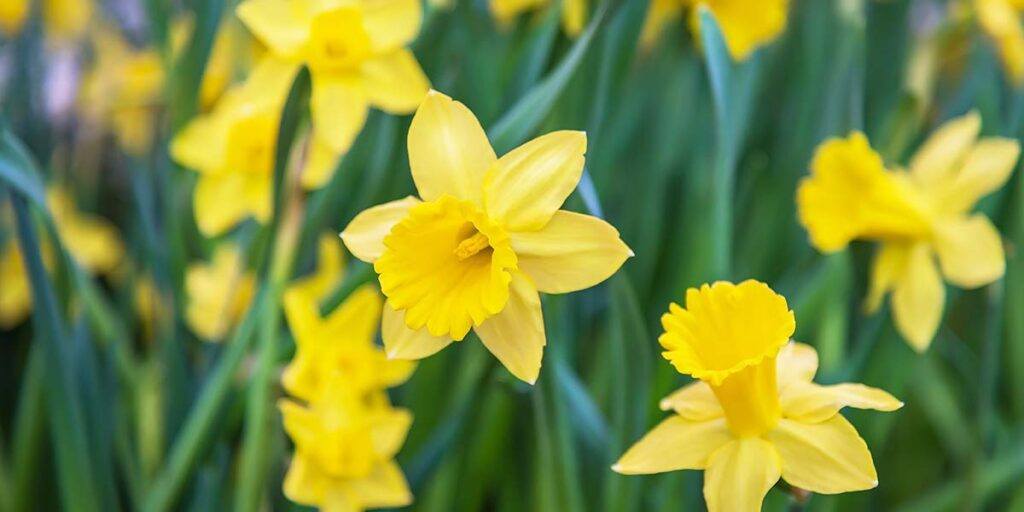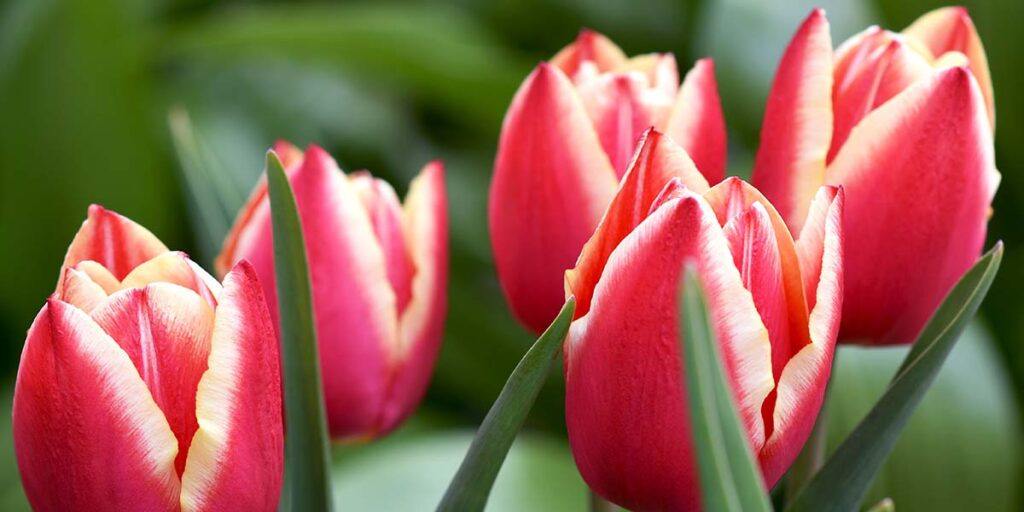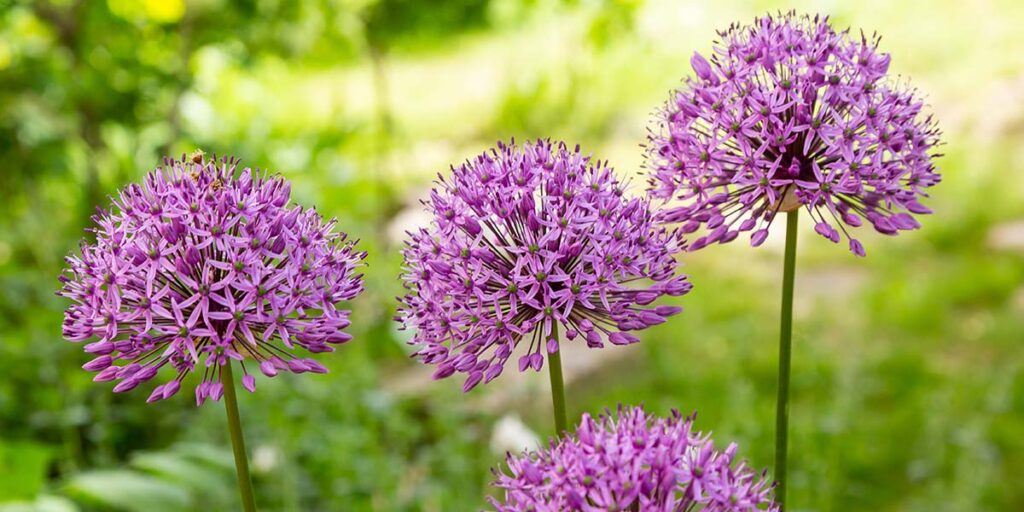Plant Bulbs Now for Spring

By Angelo Randaci, Earth’s Ally Horticulturist
Angelo’s passion for plants has led him to explore many areas of horticulture including research, grounds management, technical training, design and nursery management.
There is nothing like treating yourself to a burst of early spring color after the coldest days of winter with an explosion of blooms from fall planted spring bulbs. Depending on your growing zone, spring bulbs will bloom from early February to mid-June. They should be planted between October and November, generally 6-8 weeks before the ground freezes.
The categories of bulbs discussed in this article are divided into two types: major and minor bulbs. The major bulbs are the larger, more showy plants in the garden such as daffodils, while minor bulbs are the more diminutive bulbs such as crocus, used as companions to other bulbs and perennials.
For succession of bloom, this can be further divided into three time periods: early spring, mid spring, and late spring.
- Early spring is late February to March
- Mid spring is April to early May
- Late spring is late May through June
Choosing from each time period will provide a continuous color addition to the perennial border. There will be overlap of blooming time periods depending on your location and the varieties that you choose.
One of the most important design considerations is to work within the broad range of blooming times within each type of bulb. A prime example of this is daylilies. Daylily varieties are available by blooming times designated as extra or very early, early, mid, mid late, late, very late and repeat bloomers. By choosing from these different categories, it is possible to have blooming daylilies from May through September. The same basic concept is true of the major and minor bulbs blooming from early through to late spring. The following is a partial list of major and minor bulbs to get you started.
Major Bulbs

Daffodils
Daffodils are among the easiest and most carefree of all the spring-flowering bulbs. If you are a novice gardener wishing to add bulbs to your garden, they are an excellent choice. Daffodils are deer/rodent resistant, and many will naturalize well providing color for years to come. Daffodils are available in early, mid, and late spring varieties. Choosing an assortment of varieties from the three categories will provide 4-6 weeks of blooms.
Culture:
Daffodils will thrive in either full sun or partial shade, but bright sunlight is best for producing big, healthy blooms. They are hardy in planting zones 3-8 and will grow in most soils that are well drained. When to plant daffodil bulbs? Anytime from mid-fall through early winter before the ground freezes. Plant bulbs pointed end up in a 6-inch hole and water thoroughly. Roots form in the fall, go dormant during winter, and resume growth when the soil warms anytime from February to April. Late snows or freezing weather will not harm emerging leaves. Blooms appear in 3-6 weeks.
Fertilizing: The best gardening practice for all your plants is to establish a well-drained soil by working in plenty of organic matter before planting. Top dress with a complete fertilizer that is low in nitrogen such as a 3-6-6 ratio when foliage emerges in the spring. Established plantings will benefit from an early spring fertilizing as well, especially if planted under trees or where there is competition for nutrients from surrounding plants.
After Care:
Remove spent flowers and stems, but do not remove the leaves. The plants need the foliage to produce food (through photosynthesis) for the following year. Maintain moisture for three weeks after blooming time and then discontinue watering. Remove the foliage when it has died back and lost its green color in about six weeks or so. Plant perennials or use planted containers to hide the unsightly leaves until leaf removal. The clumps will continue to multiply each season and will eventually need dividing in three to five years. Divide them while the foliage is still green within a month after flowering.
Daffodils for Naturalizing
Purchase daffodils for naturalizing either by single varieties or as a naturalizing mix. Early blooming varieties include Barrett Browning and Tete a Tete. Midseason varieties include Mount Hood and Ice Follies, and two late blooming varieties would include Actaea and Cheerfulness.

Tulips
There are more than a dozen categories of tulips. Each type has its own qualities and blooming period. By picking from early, mid, and late season varieties, you can enjoy tulip flowers for six weeks or more. Blooming times will vary depending on where you live but generally, early tulips will bloom from March into April with mid-season and late varieties blooming later into spring. Emperor, double early, and single early tulips are early bloomers. Late blooming varieties include Darwin hybrids, Greigii Tulips, Parrot Tulips, and Lily-flowered Tulips, with Single Late and Double Late Tulips blooming latest. A cooler spring will encourage longer blooms.
Culture
Tulips will grow in sun or part shaded locations in plating zones 3-8. Plant in a loose, well-draining soil. Add compost to improve drainage in heavy soils. Two of the most common questions asked are when to plant tulip bulbs and how to plant tulip bulbs. Plant bulbs anytime in mid to late fall before the ground freezes. Plant them 6 to 8 inches deep and 4 to 5 inches apart on center. Tulip bulbs develop roots in the fall, then go dormant until temperatures warm in the spring. The emerging leaves are cold hardy and can withstand late snows and freezing temperatures.
After Care
Unlike daffodils, tulips are often treated as annuals because they tend to diminish in number and size of blossoms after the first year. For this reason, many gardeners remove the entire plant after flowering and replant with fresh, new bulbs in the fall. For those who do not wish to replant every year, Darwin hybrids, and species tulips are more likely to rebloom the second season. In this case, remove spent flowers immediately after blooming but allow the stem and foliage to continue growing. This will produce energy to develop flowers next year although they may be smaller in size and number. Bulb catalogs will often list which bulbs are suitable for naturalizing.

Alliums
Alliums will fill the gap between spring-flowering bulbs and summer perennials by blooming with the last tulips. Depending on variety, they will provide color in late spring into early summer. Besides providing a dramatic accent in the garden, they are pollinator-friendly to bees and butterflies.
Culture
Alliums are winter hardy in planting zones 3-8. They are best planted in full sun, but most types are tolerant of partial shade. Soil conditions are much the same as for the other bulbs mentioned in this article; provide a loose, well-drained soil with plenty of compost added for drainage as well as nutrition. Alliums grown from bulbs are planted in the fall before the ground freezes. These are not to be confused with herbaceous-type alliums which may be planted anytime during the growing season along with other perennials. Large variety allium bulbs should be planted 5-6 inches deep and smaller varieties 3 inches deep. As a general rule, plant allium bulbs to a depth equal to two-and-a-half times the height of the bulb. Follow planting directions included with your bulbs. Choose from the early, mid, and late blooming varieties to extend blooming times. Early blooming varieties include Allium ‘Purple Sensation’, and ‘Mt Everest’. Mid blooming varieties such as ‘Globemaster’ and ‘Graceful’ will bloom a little later, and Allium nigrum and A. ‘Gladiator’ will bloom during the early summer months.
After care
You may remove the flower heads after they have finished flowering but allow the foliage to die back completely before cutting. You may keep the spent flower heads as an ornamental feature, but some types will reseed, spreading seedlings throughout the garden. If this is undesirable, it is best to remove the seed heads before seeds are produced. The bulbs are perennial and will return seasonally.
Minor Bulbs
The following bulbs are a partial list of bulbs to purchase now that will bloom in early spring. Plant in well-drained sites to avoid root and bulb rot. The bulbs grow best in full sun, but most will adapt to shadier spots since most bulbs are active before deciduous trees leaf out. They present the best effect when used in masses and work well in rock gardens or edging paths and walkways. Some of the minor bulbs such as crocus and scillas naturalize beautifully in lawns.
Augment your garden design with these smaller bulbs by combining them with tulips, daffodils, for a carpet of color. All will naturalize except for the common hyacinths. Check your catalog for pictures and culture information. The following is a partial list of minor bulbs.
- Glory-of-the-Snow (Chionodoxa luciliae) Zone 3-8 -Height 4-6 inches. The blue, white, or pink flowers bloom anytime between January and March in northern temperate zones. Plant 3 inches deep and 3 inches apart. They are good for naturalizing in partial shade to full sun. They will multiply by self-seeding.
- Crocus (Crocus species) Zone 3-8 – Height 6-8 inches. Plant 3 inches deep and 4 inches apart. Good for naturalizing and may be naturalized in lawns if the foliage is allowed to mature and die back naturally. There are numerous varieties that bloom in autumn, winter, and spring. Review the varieties offered before making a decision.
- Checkered Lily (Fritillaria meleagris) Zone 4-8 – Height 9-15 inches. Plant 4 to 6 inches deep and 4to 6 inches apart. Plant in full sun to light shade in moist, well-drained soil. The maroon checkered flowers bloom from March to May. Propagate by dividing clumps after the foliage ripens.
- Common Snowdrop (Galanthus nivalis) Zone 3-8 – Height 6-8 inches. Snowdrops have delicate, white nodding flowers that bloom before most other spring bulbs. Plant 3 inches deep and 3 inches apart. Plant in partial to full shade in moist, well-drained soil. Good for naturalizing. Propagate by dividing clumps after flowering.
- Common Grape Hyacinth (Muscari armeniacum) Zone 3-9 – Height 6-8 inches. Grape hyacinths resemble miniature hyacinths. The blue spikes of flowers are clustered like berries. Foliage remains green through winter and goes dormant in summer. Grow in full sun to partial shade in well-drained soil. They self-sow readily, forming carpets of deep blue fragrant flowers.
- Siberian Squill (Scilla siberica) – Zone 4-8– Height 6 inches. Plant 3 inches deep and 4-6 inches apart. Grow in full sun or partial shade. The deep blue, bell-like flowers emerge over tufts of grass-like foliage from March through April. They will naturalize over time and will naturalize in lawns as well.
- Common Hyacinthus (Hyacinthus orientalis) Zone 4-8 – Height up to 12 inches. Plant 7 inches deep and 6-9 inches apart. Plant in full sun. Not good for naturalizing as the floral display gradually decreases each year.
Growing Spring Bulbs in Warm Climates
You can still grow spring-blooming bulbs if you live in warmer climates in zones 8-11. Because warmer zones lack the cooler temperatures needed for proper growth, they require pre-chilling for 12-16 weeks at 35-45 degrees F. Begin the chilling process in October and plant after the allotted chilling period during which roots will begin to form. Plant immediately and treat them as annuals. If chilling in the refrigerator, store them in ventilated bags to retain moisture. Do not store with fruit because the ethylene gas given off by the fruit will damage forming flowers within the bulb.
Growing and Designing Tips:
- Whichever type bulb you are planting, purchase the largest bulbs available. They will produce the best flowers. The bulbs should feel solid (not dry or soft).
- Bulbs will bloom before most perennials. Bulbs are a great way to have color when temperatures warm up in the spring.
- Bulbs look best when planted in groups rather than in straight rows. Plant in large drifts for a dramatic effect or weave your bulbs in with perennials to add color and texture.
- If using a granular fertilizer, slow release is best. This is sound advice for all your garden plants. A fertilizer formulated for bulbs will contain all the nutrients needed for growth.
- Deer-resistant bulbs include snowdrops, daffodils, crocus, fritillarias, and alliums. Tulips however, are not resistant and will need protection. Place chicken wire over newly planted bulbs. The foliage will grow through the wire in the spring.
- Remove spent flower heads. Allow foliage to grow until it dies back naturally. Hide unsightly foliage with perennials or planted containers.
- Do some research to find which bulbs work best in your growing zone. Bulbs that are not hardy in your area will need to be removed and stored before winter. There are planting zone maps available online where you can input your zip code to receive recommendations on the best choices for your area.
- Plant bulbs in containers to brighten up areas around your home. Make sure your containers have drainage holes and use a well-draining potting mix. Over winter the containers someplace that stays consistently cold without freezing. A garage or shed may be suitable.
- Mark newly planted areas with garden tags or flags so you won’t damage them in the spring by digging or weeding in your garden.
We’d love to hear how Earth’s Ally is helping your beautiful bulb gardens. Share your experience and stay connected with the #EarthsAlly community on Facebook, Instagram and Twitter for access to our latest blog posts, giveaways and exclusive promotions.
